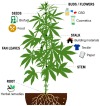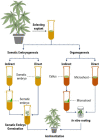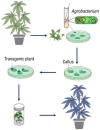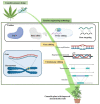Advances and Perspectives in Tissue Culture and Genetic Engineering of Cannabis
- PMID: 34073522
- PMCID: PMC8197860
- DOI: 10.3390/ijms22115671
Advances and Perspectives in Tissue Culture and Genetic Engineering of Cannabis
Abstract
For a long time, Cannabis sativa has been used for therapeutic and industrial purposes. Due to its increasing demand in medicine, recreation, and industry, there is a dire need to apply new biotechnological tools to introduce new genotypes with desirable traits and enhanced secondary metabolite production. Micropropagation, conservation, cell suspension culture, hairy root culture, polyploidy manipulation, and Agrobacterium-mediated gene transformation have been studied and used in cannabis. However, some obstacles such as the low rate of transgenic plant regeneration and low efficiency of secondary metabolite production in hairy root culture and cell suspension culture have restricted the application of these approaches in cannabis. In the current review, in vitro culture and genetic engineering methods in cannabis along with other promising techniques such as morphogenic genes, new computational approaches, clustered regularly interspaced short palindromic repeats (CRISPR), CRISPR/Cas9-equipped Agrobacterium-mediated genome editing, and hairy root culture, that can help improve gene transformation and plant regeneration, as well as enhance secondary metabolite production, have been highlighted and discussed.
Keywords: gene transformation; genome editing; haploid production; hemp; in vitro culture; marijuana; morphogenic genes; organogenesis; polyploidy; somatic embryogenesis.
Conflict of interest statement
The authors declare no conflict of interest. The funders had no role in the design of the study; in the collection, analyses, or interpretation of data; in the writing of the manuscript, or in the decision to publish the results.
Figures









Similar articles
-
Establishment of an Agrobacterium-mediated genetic transformation and CRISPR/Cas9-mediated targeted mutagenesis in Hemp (Cannabis Sativa L.).Plant Biotechnol J. 2021 Oct;19(10):1979-1987. doi: 10.1111/pbi.13611. Epub 2021 Jun 23. Plant Biotechnol J. 2021. PMID: 33960612 Free PMC article.
-
Gene Editing in Sorghum Through Agrobacterium.Methods Mol Biol. 2019;1931:155-168. doi: 10.1007/978-1-4939-9039-9_11. Methods Mol Biol. 2019. PMID: 30652289
-
Application of genetics and biotechnology for improving medicinal plants.Planta. 2019 Apr;249(4):953-973. doi: 10.1007/s00425-019-03099-1. Epub 2019 Feb 4. Planta. 2019. PMID: 30715560 Review.
-
Efficient CRISPR-mediated base editing in Agrobacterium spp.Proc Natl Acad Sci U S A. 2021 Jan 12;118(2):e2013338118. doi: 10.1073/pnas.2013338118. Epub 2020 Dec 21. Proc Natl Acad Sci U S A. 2021. PMID: 33443212 Free PMC article.
-
CRISPR/Cas: A powerful tool for gene function study and crop improvement.J Adv Res. 2020 Oct 21;29:207-221. doi: 10.1016/j.jare.2020.10.003. eCollection 2021 Mar. J Adv Res. 2020. PMID: 33842017 Free PMC article. Review.
Cited by
-
Naturally Occurring Triploidy in Cannabis.Plants (Basel). 2023 Nov 22;12(23):3927. doi: 10.3390/plants12233927. Plants (Basel). 2023. PMID: 38068564 Free PMC article.
-
Novel Insights into the Nature of Intraspecific Genome Size Diversity in Cannabis sativa L.Plants (Basel). 2022 Oct 16;11(20):2736. doi: 10.3390/plants11202736. Plants (Basel). 2022. PMID: 36297761 Free PMC article.
-
Cannabis sativa: origin and history, glandular trichome development, and cannabinoid biosynthesis.Hortic Res. 2023 Jul 26;10(9):uhad150. doi: 10.1093/hr/uhad150. eCollection 2023 Sep. Hortic Res. 2023. PMID: 37691962 Free PMC article.
-
A Temporary Immersion System to Improve Cannabis sativa Micropropagation.Front Plant Sci. 2022 Jun 23;13:895971. doi: 10.3389/fpls.2022.895971. eCollection 2022. Front Plant Sci. 2022. PMID: 35812929 Free PMC article.
-
Transcriptomic Profiling of Embryogenic and Non-Embryogenic Callus Provides New Insight into the Nature of Recalcitrance in Cannabis.Int J Mol Sci. 2023 Sep 27;24(19):14625. doi: 10.3390/ijms241914625. Int J Mol Sci. 2023. PMID: 37834075 Free PMC article.
References
-
- Hesami M., Pepe M., Alizadeh M., Rakei A., Baiton A., Jones A.M.P. Recent advances in cannabis biotechnology. Ind. Crop. Prod. 2020;158:113026. doi: 10.1016/j.indcrop.2020.113026. - DOI
-
- Schultz C.J., Lim W.L., Khor S.F., Neumann K.A., Schulz J.M., Ansari O., Skewes M.A., Burton R.A. Consumer and health-related traits of seed from selected commercial and breeding lines of industrial hemp, Cannabis sativa L. J. Agric. Food Res. 2020;2:100025. doi: 10.1016/j.jafr.2020.100025. - DOI
Publication types
MeSH terms
Grants and funding
LinkOut - more resources
Full Text Sources
Other Literature Sources

